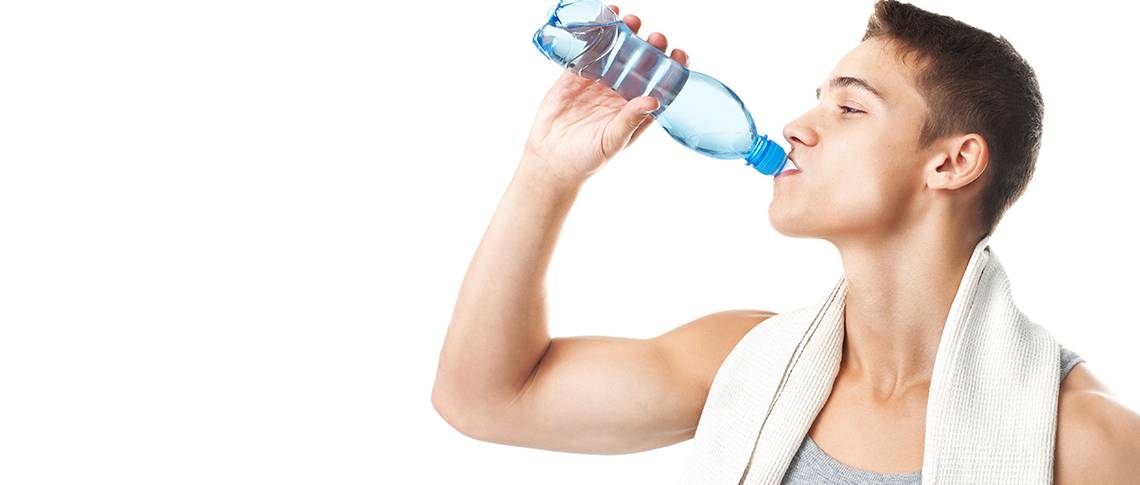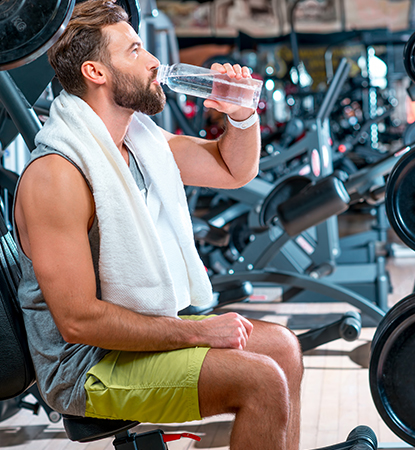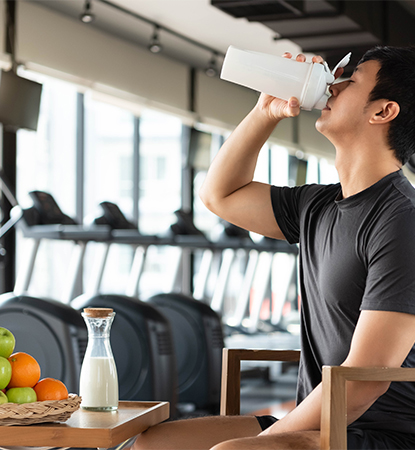
Hydratation and Micronutriments
Nutrition and sport
Compensate for water losses
Physical activity leads to water losses through the skin (sweat), the respiratory system (especially when the air is dry) and the urine.
Only the evaporation of sweat on the surface of your skin can eliminate the heat produced by physical activity and therefore maintain your body at a temperature compatible with the continuation of muscular activity.

A water loss of 2% induces a drop in your performance by 20%. Dehydration of more than 4% of body weight would be dangerous. This is why the American College of Sports Medicine recommends consuming between 600 and 1200 ml of water per hour of effort.
Dehydration promotes tendonitis, cramps and other muscle disturbances. Hydrating is physiologically essential. Physioperf drinks guarantee optimal hydration and a carbohydrate intake adapted to your needs.
Tips for optimal hydration
- Learn to hydrate yourself during training ;
- Choose a drink suited to the effort and the temperature ;
- Drink from the start of the effort, never wait for the feeling of thirst, it's already too late !
- Hydrate at the end of the effort for better recovery.
It is important to hydrate regularly before, during and after exercise, favoring, in theory, the absorption of large volumes, of the order of 150 to 200 ml. In practice, the problem is more complex due to individual tolerance to distension and filling of the stomach. Everyone must therefore determine the maximum volume that they can ingest per intake in order to avoid any discomfort during exercise.
Bring antioxidants
During exercise, the sportsman's body is subjected to an increased production of free radicals. These very reactive and harmful molecules are naturally generated by our organism from oxygen, due to :
- increased oxygen consumption ;
- inflammatory reactions ;
- ischemia-reperfusion processes in the tissues. Free radicals are the cause of oxidative damage leading to muscle and tendon microlesions which, in the long run, can lead to real injuries.
To prevent these potentially harmful effects, you must :
- Favor a varied diet, rich in fresh fruits and vegetables containing many antioxidants (vitamins C and E, selenium, zinc, chromium, vitamins B2 and B6, polyphenols, lycopene, carotenoids ...) ;
- Consume specific antioxidant food supplements ;
- Consume energy products supplemented with natural antioxidants (PHYSIOPERF range).
Effect of training on the antioxidant system :
Regular training leads to coping mechanisms. In particular, it increases the body's resistance to the production of free radicals by improving its antioxidant defenses. Indeed, regular physical exercise allows an increase in the activity of antioxidant defense enzymes. In return, the reserves of antioxidant vitamins and minerals are reduced because they are used for the functioning of these enzymes. It is therefore necessary to provide athletes with antioxidant supplementation to help restore their energy reserves.

How to choose the right drink before, during or after exercise ?
Intestinal fluid absorption is mainly governed by the osmolarity (relative concentration) of the drink.
The osmolarity of the blood is between 280 and 300 mosm / L.
- If the drink is too concentrated (hypertonic), water passes from the body to the intestine to dilute the ingested solution, that is to say that the water is secreted by the body rather than absorbed . Thus, a hypertonic liquid (fruit juice, sodas, etc.) increases dehydration by causing a transfer of water from the cells to the digestive tract.
- If the drink is less concentrated than body fluids (hypotonic), water will be transferred from the intestine to the body. A hypotonic drink is therefore particularly suitable for exercise. It is very well tolerated by the body, does not cause intestinal disorders and quickly rehydrates the body without loading the stomach.
- If the drink is at the same concentration as the body fluids (isotonic), it will also be well absorbed by the body.
We therefore understand that a drink for waiting, or effort or recovery must be composed of electrolytes, micronutrients (compensation for sweat loss) and carbohydrates (energy intake) while remaining hypotonic, isotonic or slightly hypertonic, without ever exceeding 320 mosm / L in order to optimize the rehydration of the organism (better gastric emptying and intestinal absorption).










